BIOL5292 - Human Dimensions of Conservation: Urbanization Report
VerifiedAdded on 2023/04/24
|10
|2390
|164
Report
AI Summary
This report examines the complex relationship between urbanization and conservation, addressing whether urbanization poses a threat or offers potential solutions for biodiversity preservation. It highlights key issues such as habitat fragmentation, pollution, human-animal conflicts, and erratic weather patterns resulting from urban expansion. The report provides evidence from various studies and real-world examples to illustrate the adverse impacts of urbanization on wildlife populations and ecosystems. Furthermore, it proposes several recommendations for mitigating these negative effects, including designing connective corridors for wildlife, utilizing urban structures as breeding sites, creating barriers around human settlements, implementing strict pollution control policies, limiting pesticide use, employing environmental impact assessments, and educating local communities. The report concludes by emphasizing the importance of integrating conservation strategies into urbanization planning to protect biodiversity and promote sustainable development and this document is available on Desklib, along with other solved assignments.
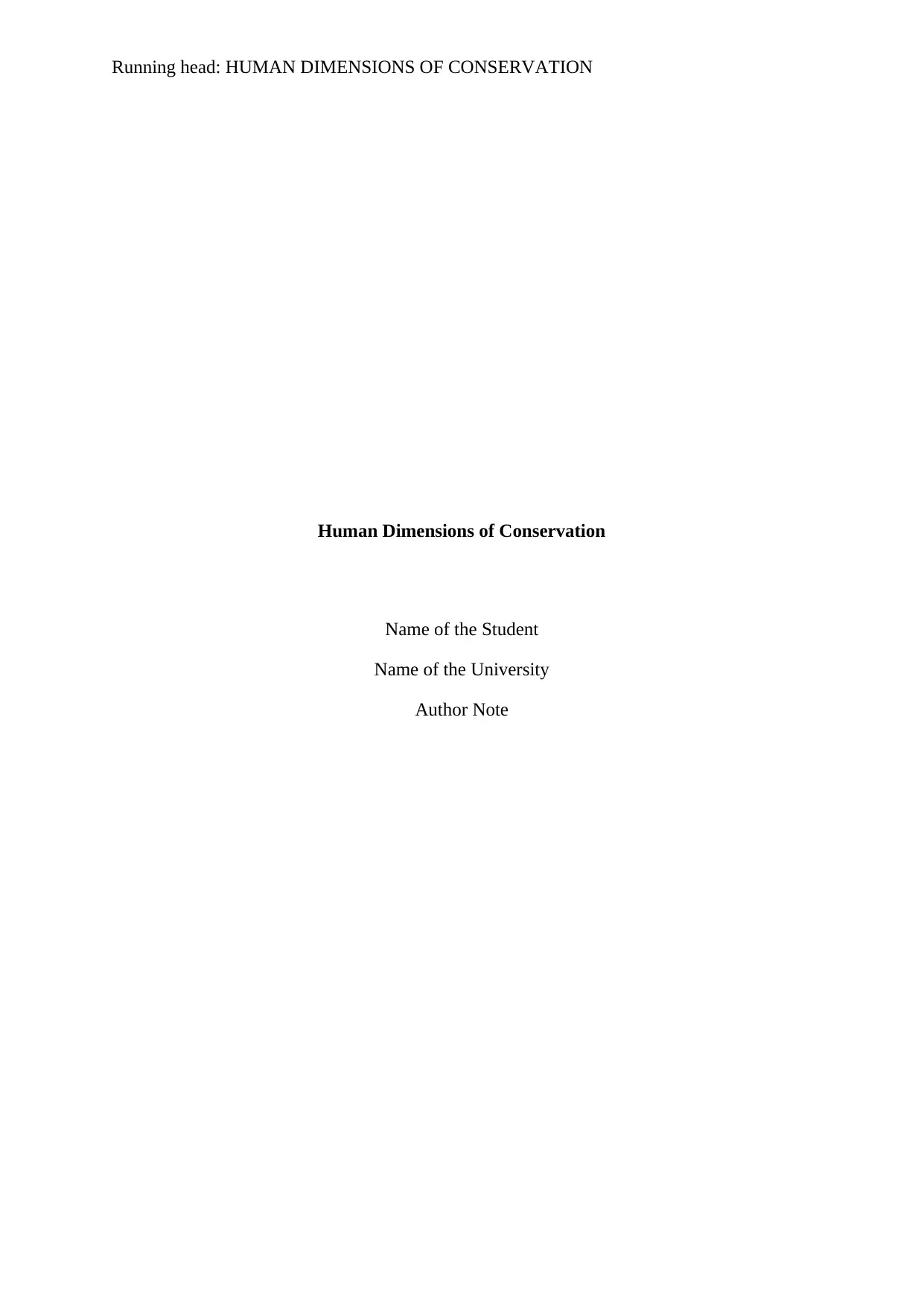
Running head: HUMAN DIMENSIONS OF CONSERVATION
Human Dimensions of Conservation
Name of the Student
Name of the University
Author Note
Human Dimensions of Conservation
Name of the Student
Name of the University
Author Note
Paraphrase This Document
Need a fresh take? Get an instant paraphrase of this document with our AI Paraphraser
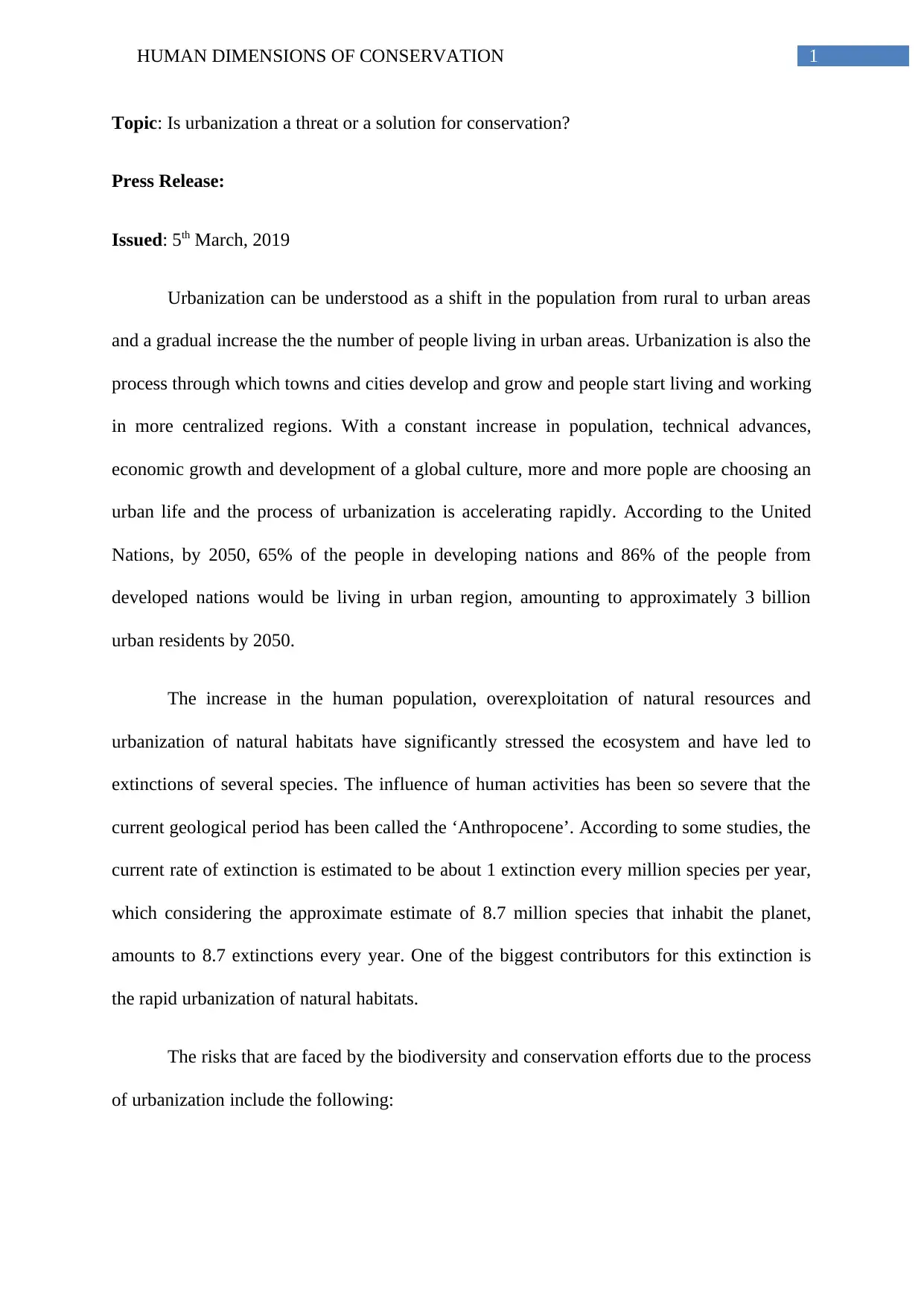
1HUMAN DIMENSIONS OF CONSERVATION
Topic: Is urbanization a threat or a solution for conservation?
Press Release:
Issued: 5th March, 2019
Urbanization can be understood as a shift in the population from rural to urban areas
and a gradual increase the the number of people living in urban areas. Urbanization is also the
process through which towns and cities develop and grow and people start living and working
in more centralized regions. With a constant increase in population, technical advances,
economic growth and development of a global culture, more and more pople are choosing an
urban life and the process of urbanization is accelerating rapidly. According to the United
Nations, by 2050, 65% of the people in developing nations and 86% of the people from
developed nations would be living in urban region, amounting to approximately 3 billion
urban residents by 2050.
The increase in the human population, overexploitation of natural resources and
urbanization of natural habitats have significantly stressed the ecosystem and have led to
extinctions of several species. The influence of human activities has been so severe that the
current geological period has been called the ‘Anthropocene’. According to some studies, the
current rate of extinction is estimated to be about 1 extinction every million species per year,
which considering the approximate estimate of 8.7 million species that inhabit the planet,
amounts to 8.7 extinctions every year. One of the biggest contributors for this extinction is
the rapid urbanization of natural habitats.
The risks that are faced by the biodiversity and conservation efforts due to the process
of urbanization include the following:
Topic: Is urbanization a threat or a solution for conservation?
Press Release:
Issued: 5th March, 2019
Urbanization can be understood as a shift in the population from rural to urban areas
and a gradual increase the the number of people living in urban areas. Urbanization is also the
process through which towns and cities develop and grow and people start living and working
in more centralized regions. With a constant increase in population, technical advances,
economic growth and development of a global culture, more and more pople are choosing an
urban life and the process of urbanization is accelerating rapidly. According to the United
Nations, by 2050, 65% of the people in developing nations and 86% of the people from
developed nations would be living in urban region, amounting to approximately 3 billion
urban residents by 2050.
The increase in the human population, overexploitation of natural resources and
urbanization of natural habitats have significantly stressed the ecosystem and have led to
extinctions of several species. The influence of human activities has been so severe that the
current geological period has been called the ‘Anthropocene’. According to some studies, the
current rate of extinction is estimated to be about 1 extinction every million species per year,
which considering the approximate estimate of 8.7 million species that inhabit the planet,
amounts to 8.7 extinctions every year. One of the biggest contributors for this extinction is
the rapid urbanization of natural habitats.
The risks that are faced by the biodiversity and conservation efforts due to the process
of urbanization include the following:
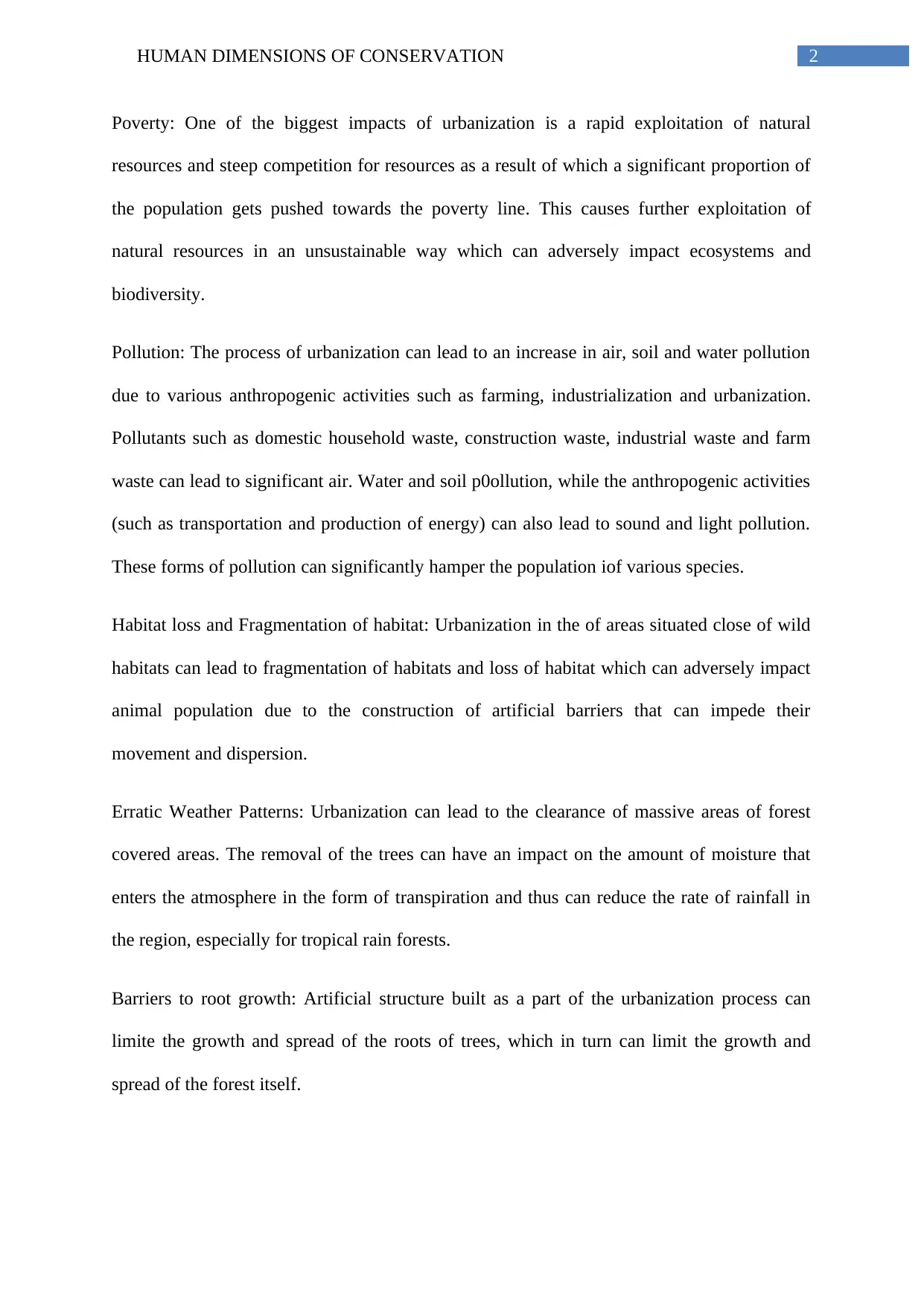
2HUMAN DIMENSIONS OF CONSERVATION
Poverty: One of the biggest impacts of urbanization is a rapid exploitation of natural
resources and steep competition for resources as a result of which a significant proportion of
the population gets pushed towards the poverty line. This causes further exploitation of
natural resources in an unsustainable way which can adversely impact ecosystems and
biodiversity.
Pollution: The process of urbanization can lead to an increase in air, soil and water pollution
due to various anthropogenic activities such as farming, industrialization and urbanization.
Pollutants such as domestic household waste, construction waste, industrial waste and farm
waste can lead to significant air. Water and soil p0ollution, while the anthropogenic activities
(such as transportation and production of energy) can also lead to sound and light pollution.
These forms of pollution can significantly hamper the population iof various species.
Habitat loss and Fragmentation of habitat: Urbanization in the of areas situated close of wild
habitats can lead to fragmentation of habitats and loss of habitat which can adversely impact
animal population due to the construction of artificial barriers that can impede their
movement and dispersion.
Erratic Weather Patterns: Urbanization can lead to the clearance of massive areas of forest
covered areas. The removal of the trees can have an impact on the amount of moisture that
enters the atmosphere in the form of transpiration and thus can reduce the rate of rainfall in
the region, especially for tropical rain forests.
Barriers to root growth: Artificial structure built as a part of the urbanization process can
limite the growth and spread of the roots of trees, which in turn can limit the growth and
spread of the forest itself.
Poverty: One of the biggest impacts of urbanization is a rapid exploitation of natural
resources and steep competition for resources as a result of which a significant proportion of
the population gets pushed towards the poverty line. This causes further exploitation of
natural resources in an unsustainable way which can adversely impact ecosystems and
biodiversity.
Pollution: The process of urbanization can lead to an increase in air, soil and water pollution
due to various anthropogenic activities such as farming, industrialization and urbanization.
Pollutants such as domestic household waste, construction waste, industrial waste and farm
waste can lead to significant air. Water and soil p0ollution, while the anthropogenic activities
(such as transportation and production of energy) can also lead to sound and light pollution.
These forms of pollution can significantly hamper the population iof various species.
Habitat loss and Fragmentation of habitat: Urbanization in the of areas situated close of wild
habitats can lead to fragmentation of habitats and loss of habitat which can adversely impact
animal population due to the construction of artificial barriers that can impede their
movement and dispersion.
Erratic Weather Patterns: Urbanization can lead to the clearance of massive areas of forest
covered areas. The removal of the trees can have an impact on the amount of moisture that
enters the atmosphere in the form of transpiration and thus can reduce the rate of rainfall in
the region, especially for tropical rain forests.
Barriers to root growth: Artificial structure built as a part of the urbanization process can
limite the growth and spread of the roots of trees, which in turn can limit the growth and
spread of the forest itself.
⊘ This is a preview!⊘
Do you want full access?
Subscribe today to unlock all pages.

Trusted by 1+ million students worldwide
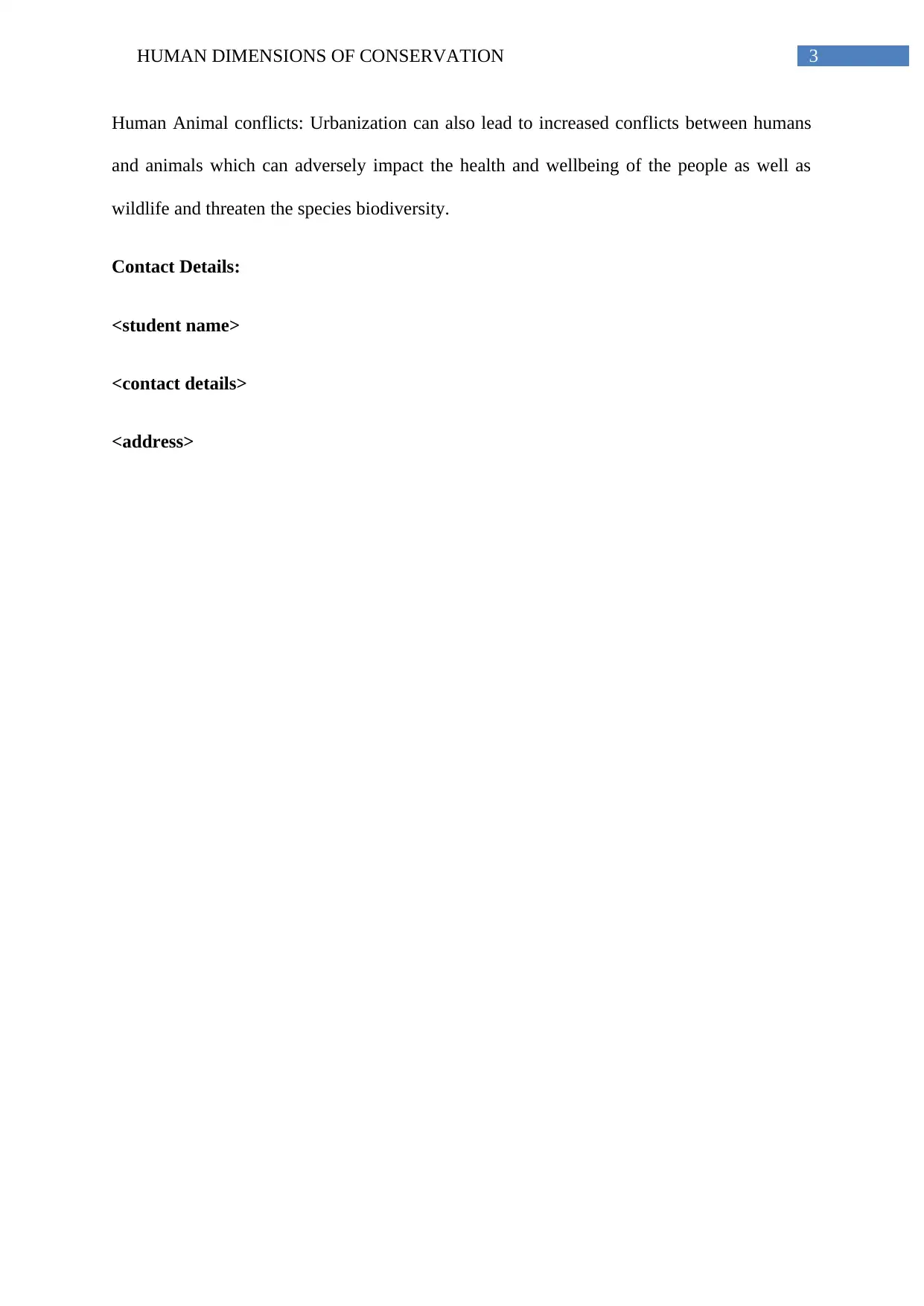
3HUMAN DIMENSIONS OF CONSERVATION
Human Animal conflicts: Urbanization can also lead to increased conflicts between humans
and animals which can adversely impact the health and wellbeing of the people as well as
wildlife and threaten the species biodiversity.
Contact Details:
<student name>
<contact details>
<address>
Human Animal conflicts: Urbanization can also lead to increased conflicts between humans
and animals which can adversely impact the health and wellbeing of the people as well as
wildlife and threaten the species biodiversity.
Contact Details:
<student name>
<contact details>
<address>
Paraphrase This Document
Need a fresh take? Get an instant paraphrase of this document with our AI Paraphraser
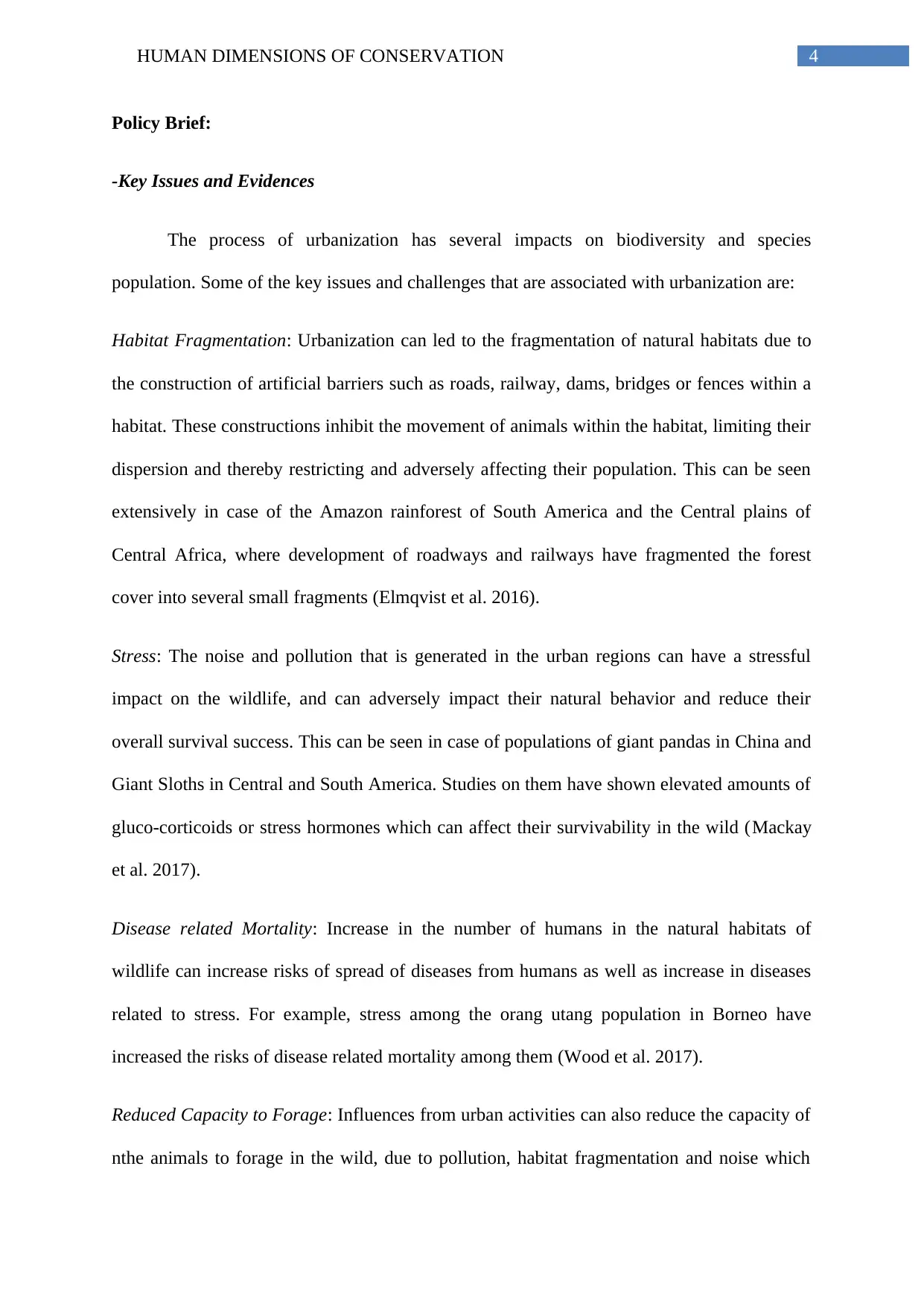
4HUMAN DIMENSIONS OF CONSERVATION
Policy Brief:
-Key Issues and Evidences
The process of urbanization has several impacts on biodiversity and species
population. Some of the key issues and challenges that are associated with urbanization are:
Habitat Fragmentation: Urbanization can led to the fragmentation of natural habitats due to
the construction of artificial barriers such as roads, railway, dams, bridges or fences within a
habitat. These constructions inhibit the movement of animals within the habitat, limiting their
dispersion and thereby restricting and adversely affecting their population. This can be seen
extensively in case of the Amazon rainforest of South America and the Central plains of
Central Africa, where development of roadways and railways have fragmented the forest
cover into several small fragments (Elmqvist et al. 2016).
Stress: The noise and pollution that is generated in the urban regions can have a stressful
impact on the wildlife, and can adversely impact their natural behavior and reduce their
overall survival success. This can be seen in case of populations of giant pandas in China and
Giant Sloths in Central and South America. Studies on them have shown elevated amounts of
gluco-corticoids or stress hormones which can affect their survivability in the wild (Mackay
et al. 2017).
Disease related Mortality: Increase in the number of humans in the natural habitats of
wildlife can increase risks of spread of diseases from humans as well as increase in diseases
related to stress. For example, stress among the orang utang population in Borneo have
increased the risks of disease related mortality among them (Wood et al. 2017).
Reduced Capacity to Forage: Influences from urban activities can also reduce the capacity of
nthe animals to forage in the wild, due to pollution, habitat fragmentation and noise which
Policy Brief:
-Key Issues and Evidences
The process of urbanization has several impacts on biodiversity and species
population. Some of the key issues and challenges that are associated with urbanization are:
Habitat Fragmentation: Urbanization can led to the fragmentation of natural habitats due to
the construction of artificial barriers such as roads, railway, dams, bridges or fences within a
habitat. These constructions inhibit the movement of animals within the habitat, limiting their
dispersion and thereby restricting and adversely affecting their population. This can be seen
extensively in case of the Amazon rainforest of South America and the Central plains of
Central Africa, where development of roadways and railways have fragmented the forest
cover into several small fragments (Elmqvist et al. 2016).
Stress: The noise and pollution that is generated in the urban regions can have a stressful
impact on the wildlife, and can adversely impact their natural behavior and reduce their
overall survival success. This can be seen in case of populations of giant pandas in China and
Giant Sloths in Central and South America. Studies on them have shown elevated amounts of
gluco-corticoids or stress hormones which can affect their survivability in the wild (Mackay
et al. 2017).
Disease related Mortality: Increase in the number of humans in the natural habitats of
wildlife can increase risks of spread of diseases from humans as well as increase in diseases
related to stress. For example, stress among the orang utang population in Borneo have
increased the risks of disease related mortality among them (Wood et al. 2017).
Reduced Capacity to Forage: Influences from urban activities can also reduce the capacity of
nthe animals to forage in the wild, due to pollution, habitat fragmentation and noise which
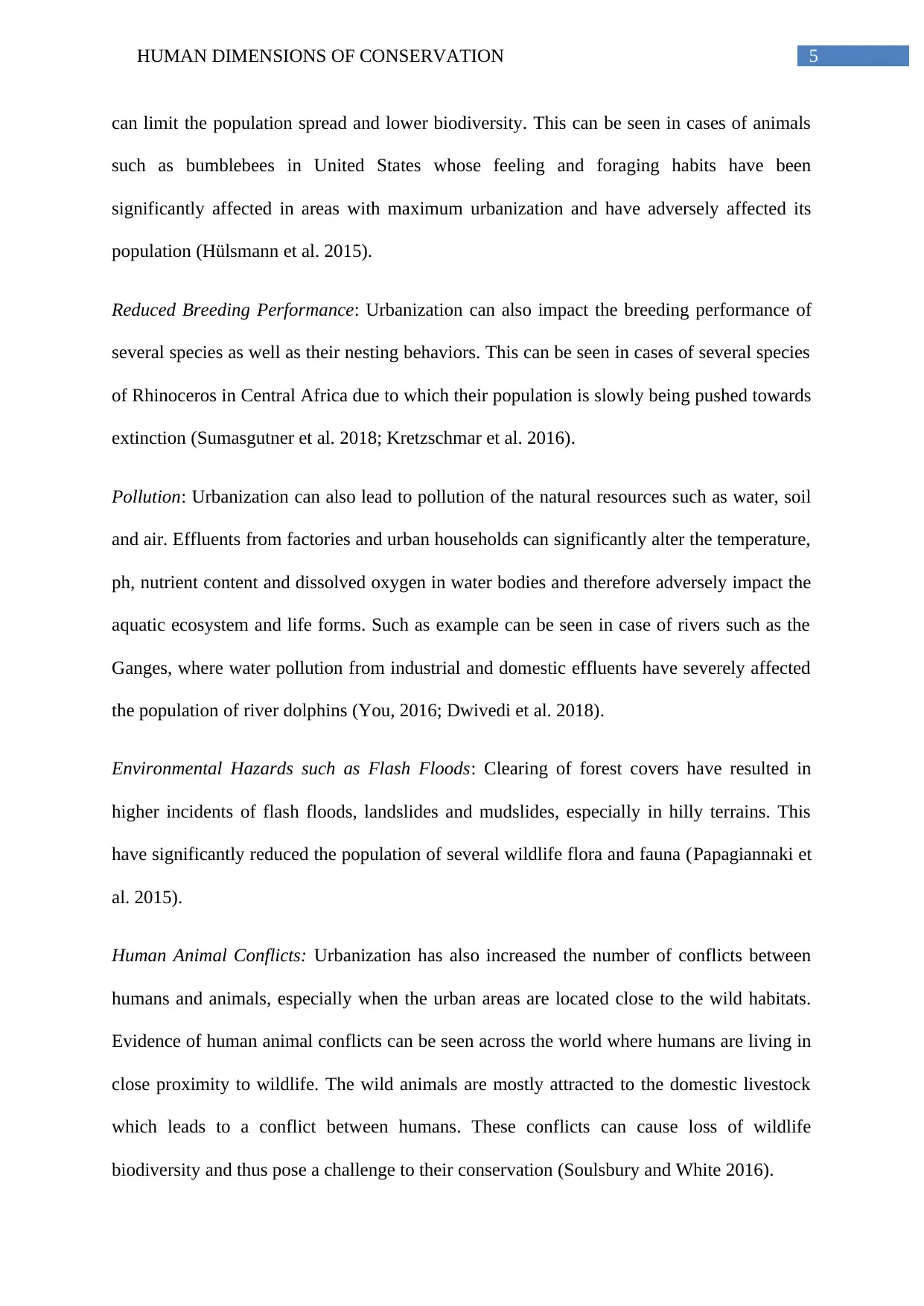
5HUMAN DIMENSIONS OF CONSERVATION
can limit the population spread and lower biodiversity. This can be seen in cases of animals
such as bumblebees in United States whose feeling and foraging habits have been
significantly affected in areas with maximum urbanization and have adversely affected its
population (Hülsmann et al. 2015).
Reduced Breeding Performance: Urbanization can also impact the breeding performance of
several species as well as their nesting behaviors. This can be seen in cases of several species
of Rhinoceros in Central Africa due to which their population is slowly being pushed towards
extinction (Sumasgutner et al. 2018; Kretzschmar et al. 2016).
Pollution: Urbanization can also lead to pollution of the natural resources such as water, soil
and air. Effluents from factories and urban households can significantly alter the temperature,
ph, nutrient content and dissolved oxygen in water bodies and therefore adversely impact the
aquatic ecosystem and life forms. Such as example can be seen in case of rivers such as the
Ganges, where water pollution from industrial and domestic effluents have severely affected
the population of river dolphins (You, 2016; Dwivedi et al. 2018).
Environmental Hazards such as Flash Floods: Clearing of forest covers have resulted in
higher incidents of flash floods, landslides and mudslides, especially in hilly terrains. This
have significantly reduced the population of several wildlife flora and fauna (Papagiannaki et
al. 2015).
Human Animal Conflicts: Urbanization has also increased the number of conflicts between
humans and animals, especially when the urban areas are located close to the wild habitats.
Evidence of human animal conflicts can be seen across the world where humans are living in
close proximity to wildlife. The wild animals are mostly attracted to the domestic livestock
which leads to a conflict between humans. These conflicts can cause loss of wildlife
biodiversity and thus pose a challenge to their conservation (Soulsbury and White 2016).
can limit the population spread and lower biodiversity. This can be seen in cases of animals
such as bumblebees in United States whose feeling and foraging habits have been
significantly affected in areas with maximum urbanization and have adversely affected its
population (Hülsmann et al. 2015).
Reduced Breeding Performance: Urbanization can also impact the breeding performance of
several species as well as their nesting behaviors. This can be seen in cases of several species
of Rhinoceros in Central Africa due to which their population is slowly being pushed towards
extinction (Sumasgutner et al. 2018; Kretzschmar et al. 2016).
Pollution: Urbanization can also lead to pollution of the natural resources such as water, soil
and air. Effluents from factories and urban households can significantly alter the temperature,
ph, nutrient content and dissolved oxygen in water bodies and therefore adversely impact the
aquatic ecosystem and life forms. Such as example can be seen in case of rivers such as the
Ganges, where water pollution from industrial and domestic effluents have severely affected
the population of river dolphins (You, 2016; Dwivedi et al. 2018).
Environmental Hazards such as Flash Floods: Clearing of forest covers have resulted in
higher incidents of flash floods, landslides and mudslides, especially in hilly terrains. This
have significantly reduced the population of several wildlife flora and fauna (Papagiannaki et
al. 2015).
Human Animal Conflicts: Urbanization has also increased the number of conflicts between
humans and animals, especially when the urban areas are located close to the wild habitats.
Evidence of human animal conflicts can be seen across the world where humans are living in
close proximity to wildlife. The wild animals are mostly attracted to the domestic livestock
which leads to a conflict between humans. These conflicts can cause loss of wildlife
biodiversity and thus pose a challenge to their conservation (Soulsbury and White 2016).
⊘ This is a preview!⊘
Do you want full access?
Subscribe today to unlock all pages.

Trusted by 1+ million students worldwide
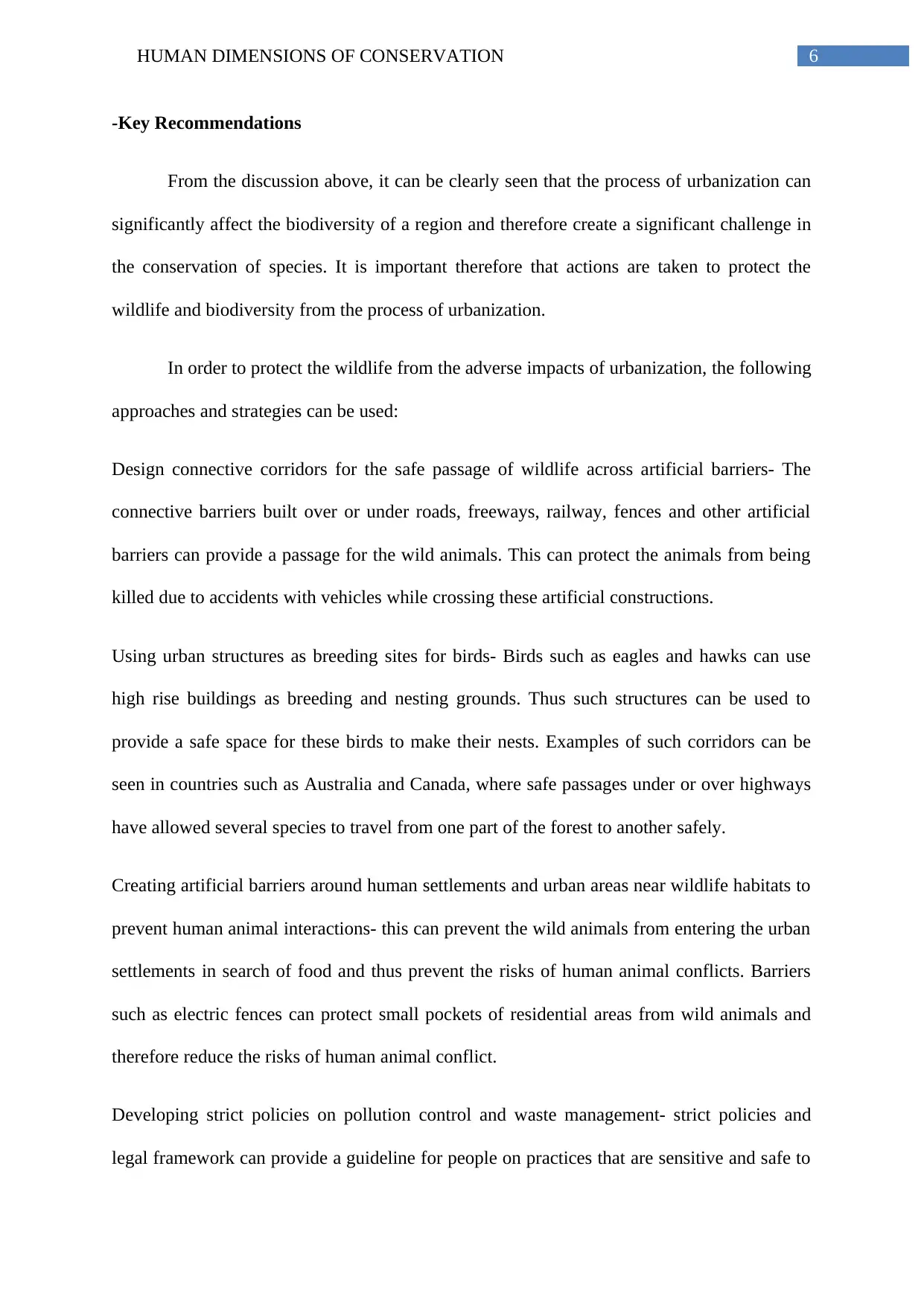
6HUMAN DIMENSIONS OF CONSERVATION
-Key Recommendations
From the discussion above, it can be clearly seen that the process of urbanization can
significantly affect the biodiversity of a region and therefore create a significant challenge in
the conservation of species. It is important therefore that actions are taken to protect the
wildlife and biodiversity from the process of urbanization.
In order to protect the wildlife from the adverse impacts of urbanization, the following
approaches and strategies can be used:
Design connective corridors for the safe passage of wildlife across artificial barriers- The
connective barriers built over or under roads, freeways, railway, fences and other artificial
barriers can provide a passage for the wild animals. This can protect the animals from being
killed due to accidents with vehicles while crossing these artificial constructions.
Using urban structures as breeding sites for birds- Birds such as eagles and hawks can use
high rise buildings as breeding and nesting grounds. Thus such structures can be used to
provide a safe space for these birds to make their nests. Examples of such corridors can be
seen in countries such as Australia and Canada, where safe passages under or over highways
have allowed several species to travel from one part of the forest to another safely.
Creating artificial barriers around human settlements and urban areas near wildlife habitats to
prevent human animal interactions- this can prevent the wild animals from entering the urban
settlements in search of food and thus prevent the risks of human animal conflicts. Barriers
such as electric fences can protect small pockets of residential areas from wild animals and
therefore reduce the risks of human animal conflict.
Developing strict policies on pollution control and waste management- strict policies and
legal framework can provide a guideline for people on practices that are sensitive and safe to
-Key Recommendations
From the discussion above, it can be clearly seen that the process of urbanization can
significantly affect the biodiversity of a region and therefore create a significant challenge in
the conservation of species. It is important therefore that actions are taken to protect the
wildlife and biodiversity from the process of urbanization.
In order to protect the wildlife from the adverse impacts of urbanization, the following
approaches and strategies can be used:
Design connective corridors for the safe passage of wildlife across artificial barriers- The
connective barriers built over or under roads, freeways, railway, fences and other artificial
barriers can provide a passage for the wild animals. This can protect the animals from being
killed due to accidents with vehicles while crossing these artificial constructions.
Using urban structures as breeding sites for birds- Birds such as eagles and hawks can use
high rise buildings as breeding and nesting grounds. Thus such structures can be used to
provide a safe space for these birds to make their nests. Examples of such corridors can be
seen in countries such as Australia and Canada, where safe passages under or over highways
have allowed several species to travel from one part of the forest to another safely.
Creating artificial barriers around human settlements and urban areas near wildlife habitats to
prevent human animal interactions- this can prevent the wild animals from entering the urban
settlements in search of food and thus prevent the risks of human animal conflicts. Barriers
such as electric fences can protect small pockets of residential areas from wild animals and
therefore reduce the risks of human animal conflict.
Developing strict policies on pollution control and waste management- strict policies and
legal framework can provide a guideline for people on practices that are sensitive and safe to
Paraphrase This Document
Need a fresh take? Get an instant paraphrase of this document with our AI Paraphraser
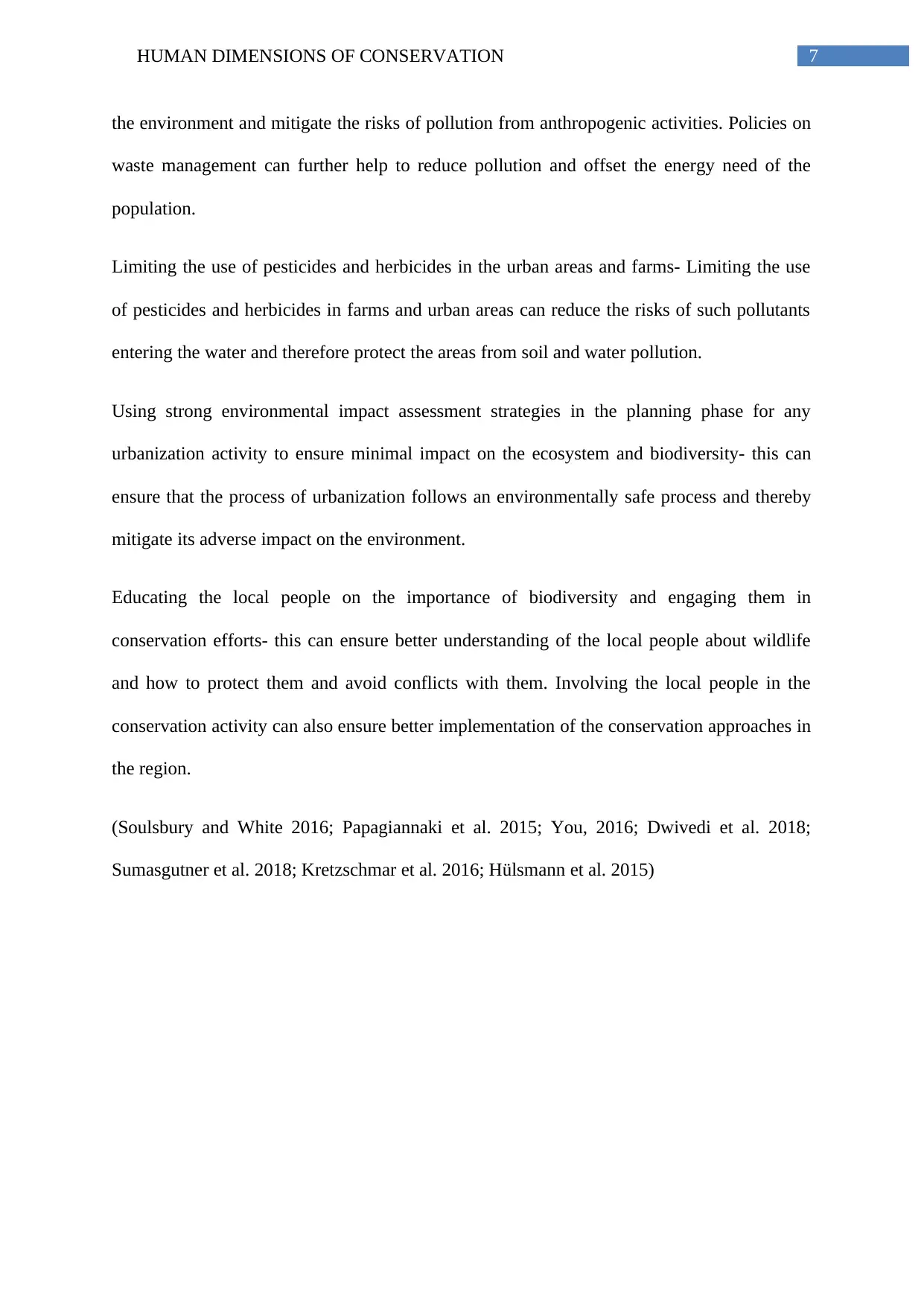
7HUMAN DIMENSIONS OF CONSERVATION
the environment and mitigate the risks of pollution from anthropogenic activities. Policies on
waste management can further help to reduce pollution and offset the energy need of the
population.
Limiting the use of pesticides and herbicides in the urban areas and farms- Limiting the use
of pesticides and herbicides in farms and urban areas can reduce the risks of such pollutants
entering the water and therefore protect the areas from soil and water pollution.
Using strong environmental impact assessment strategies in the planning phase for any
urbanization activity to ensure minimal impact on the ecosystem and biodiversity- this can
ensure that the process of urbanization follows an environmentally safe process and thereby
mitigate its adverse impact on the environment.
Educating the local people on the importance of biodiversity and engaging them in
conservation efforts- this can ensure better understanding of the local people about wildlife
and how to protect them and avoid conflicts with them. Involving the local people in the
conservation activity can also ensure better implementation of the conservation approaches in
the region.
(Soulsbury and White 2016; Papagiannaki et al. 2015; You, 2016; Dwivedi et al. 2018;
Sumasgutner et al. 2018; Kretzschmar et al. 2016; Hülsmann et al. 2015)
the environment and mitigate the risks of pollution from anthropogenic activities. Policies on
waste management can further help to reduce pollution and offset the energy need of the
population.
Limiting the use of pesticides and herbicides in the urban areas and farms- Limiting the use
of pesticides and herbicides in farms and urban areas can reduce the risks of such pollutants
entering the water and therefore protect the areas from soil and water pollution.
Using strong environmental impact assessment strategies in the planning phase for any
urbanization activity to ensure minimal impact on the ecosystem and biodiversity- this can
ensure that the process of urbanization follows an environmentally safe process and thereby
mitigate its adverse impact on the environment.
Educating the local people on the importance of biodiversity and engaging them in
conservation efforts- this can ensure better understanding of the local people about wildlife
and how to protect them and avoid conflicts with them. Involving the local people in the
conservation activity can also ensure better implementation of the conservation approaches in
the region.
(Soulsbury and White 2016; Papagiannaki et al. 2015; You, 2016; Dwivedi et al. 2018;
Sumasgutner et al. 2018; Kretzschmar et al. 2016; Hülsmann et al. 2015)
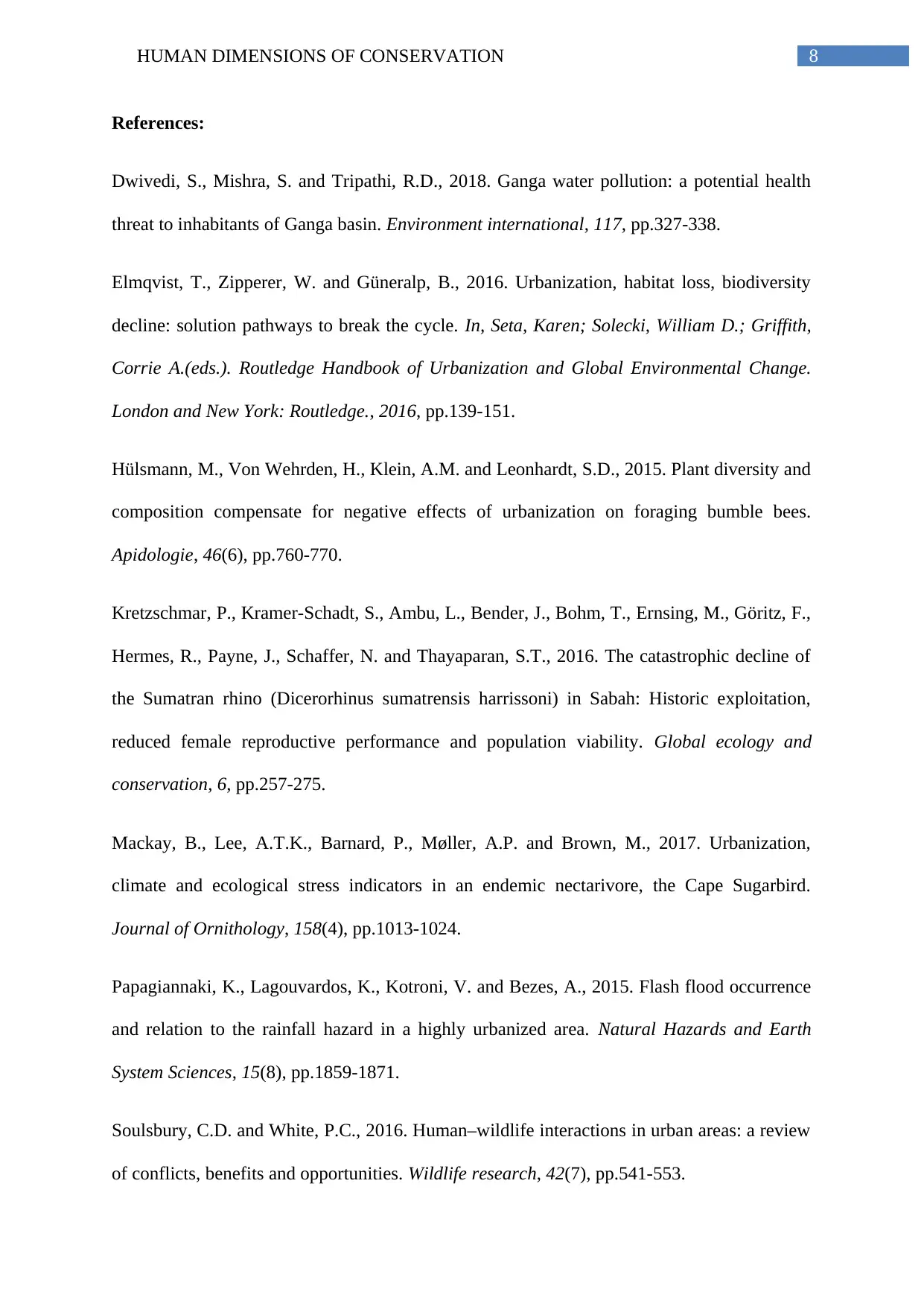
8HUMAN DIMENSIONS OF CONSERVATION
References:
Dwivedi, S., Mishra, S. and Tripathi, R.D., 2018. Ganga water pollution: a potential health
threat to inhabitants of Ganga basin. Environment international, 117, pp.327-338.
Elmqvist, T., Zipperer, W. and Güneralp, B., 2016. Urbanization, habitat loss, biodiversity
decline: solution pathways to break the cycle. In, Seta, Karen; Solecki, William D.; Griffith,
Corrie A.(eds.). Routledge Handbook of Urbanization and Global Environmental Change.
London and New York: Routledge., 2016, pp.139-151.
Hülsmann, M., Von Wehrden, H., Klein, A.M. and Leonhardt, S.D., 2015. Plant diversity and
composition compensate for negative effects of urbanization on foraging bumble bees.
Apidologie, 46(6), pp.760-770.
Kretzschmar, P., Kramer-Schadt, S., Ambu, L., Bender, J., Bohm, T., Ernsing, M., Göritz, F.,
Hermes, R., Payne, J., Schaffer, N. and Thayaparan, S.T., 2016. The catastrophic decline of
the Sumatran rhino (Dicerorhinus sumatrensis harrissoni) in Sabah: Historic exploitation,
reduced female reproductive performance and population viability. Global ecology and
conservation, 6, pp.257-275.
Mackay, B., Lee, A.T.K., Barnard, P., Møller, A.P. and Brown, M., 2017. Urbanization,
climate and ecological stress indicators in an endemic nectarivore, the Cape Sugarbird.
Journal of Ornithology, 158(4), pp.1013-1024.
Papagiannaki, K., Lagouvardos, K., Kotroni, V. and Bezes, A., 2015. Flash flood occurrence
and relation to the rainfall hazard in a highly urbanized area. Natural Hazards and Earth
System Sciences, 15(8), pp.1859-1871.
Soulsbury, C.D. and White, P.C., 2016. Human–wildlife interactions in urban areas: a review
of conflicts, benefits and opportunities. Wildlife research, 42(7), pp.541-553.
References:
Dwivedi, S., Mishra, S. and Tripathi, R.D., 2018. Ganga water pollution: a potential health
threat to inhabitants of Ganga basin. Environment international, 117, pp.327-338.
Elmqvist, T., Zipperer, W. and Güneralp, B., 2016. Urbanization, habitat loss, biodiversity
decline: solution pathways to break the cycle. In, Seta, Karen; Solecki, William D.; Griffith,
Corrie A.(eds.). Routledge Handbook of Urbanization and Global Environmental Change.
London and New York: Routledge., 2016, pp.139-151.
Hülsmann, M., Von Wehrden, H., Klein, A.M. and Leonhardt, S.D., 2015. Plant diversity and
composition compensate for negative effects of urbanization on foraging bumble bees.
Apidologie, 46(6), pp.760-770.
Kretzschmar, P., Kramer-Schadt, S., Ambu, L., Bender, J., Bohm, T., Ernsing, M., Göritz, F.,
Hermes, R., Payne, J., Schaffer, N. and Thayaparan, S.T., 2016. The catastrophic decline of
the Sumatran rhino (Dicerorhinus sumatrensis harrissoni) in Sabah: Historic exploitation,
reduced female reproductive performance and population viability. Global ecology and
conservation, 6, pp.257-275.
Mackay, B., Lee, A.T.K., Barnard, P., Møller, A.P. and Brown, M., 2017. Urbanization,
climate and ecological stress indicators in an endemic nectarivore, the Cape Sugarbird.
Journal of Ornithology, 158(4), pp.1013-1024.
Papagiannaki, K., Lagouvardos, K., Kotroni, V. and Bezes, A., 2015. Flash flood occurrence
and relation to the rainfall hazard in a highly urbanized area. Natural Hazards and Earth
System Sciences, 15(8), pp.1859-1871.
Soulsbury, C.D. and White, P.C., 2016. Human–wildlife interactions in urban areas: a review
of conflicts, benefits and opportunities. Wildlife research, 42(7), pp.541-553.
⊘ This is a preview!⊘
Do you want full access?
Subscribe today to unlock all pages.

Trusted by 1+ million students worldwide
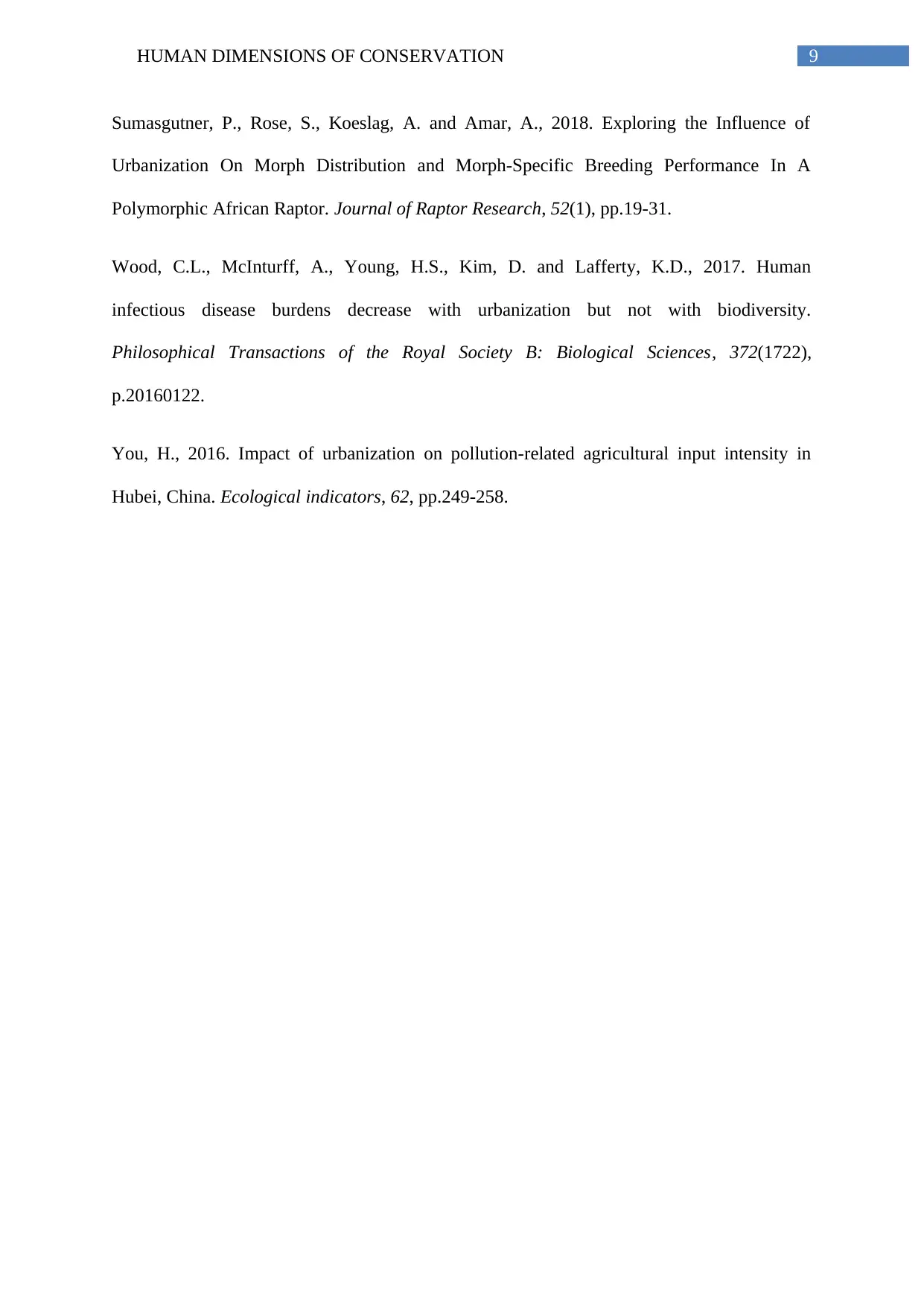
9HUMAN DIMENSIONS OF CONSERVATION
Sumasgutner, P., Rose, S., Koeslag, A. and Amar, A., 2018. Exploring the Influence of
Urbanization On Morph Distribution and Morph-Specific Breeding Performance In A
Polymorphic African Raptor. Journal of Raptor Research, 52(1), pp.19-31.
Wood, C.L., McInturff, A., Young, H.S., Kim, D. and Lafferty, K.D., 2017. Human
infectious disease burdens decrease with urbanization but not with biodiversity.
Philosophical Transactions of the Royal Society B: Biological Sciences, 372(1722),
p.20160122.
You, H., 2016. Impact of urbanization on pollution-related agricultural input intensity in
Hubei, China. Ecological indicators, 62, pp.249-258.
Sumasgutner, P., Rose, S., Koeslag, A. and Amar, A., 2018. Exploring the Influence of
Urbanization On Morph Distribution and Morph-Specific Breeding Performance In A
Polymorphic African Raptor. Journal of Raptor Research, 52(1), pp.19-31.
Wood, C.L., McInturff, A., Young, H.S., Kim, D. and Lafferty, K.D., 2017. Human
infectious disease burdens decrease with urbanization but not with biodiversity.
Philosophical Transactions of the Royal Society B: Biological Sciences, 372(1722),
p.20160122.
You, H., 2016. Impact of urbanization on pollution-related agricultural input intensity in
Hubei, China. Ecological indicators, 62, pp.249-258.
1 out of 10
Related Documents
Your All-in-One AI-Powered Toolkit for Academic Success.
+13062052269
info@desklib.com
Available 24*7 on WhatsApp / Email
![[object Object]](/_next/static/media/star-bottom.7253800d.svg)
Unlock your academic potential
Copyright © 2020–2025 A2Z Services. All Rights Reserved. Developed and managed by ZUCOL.





